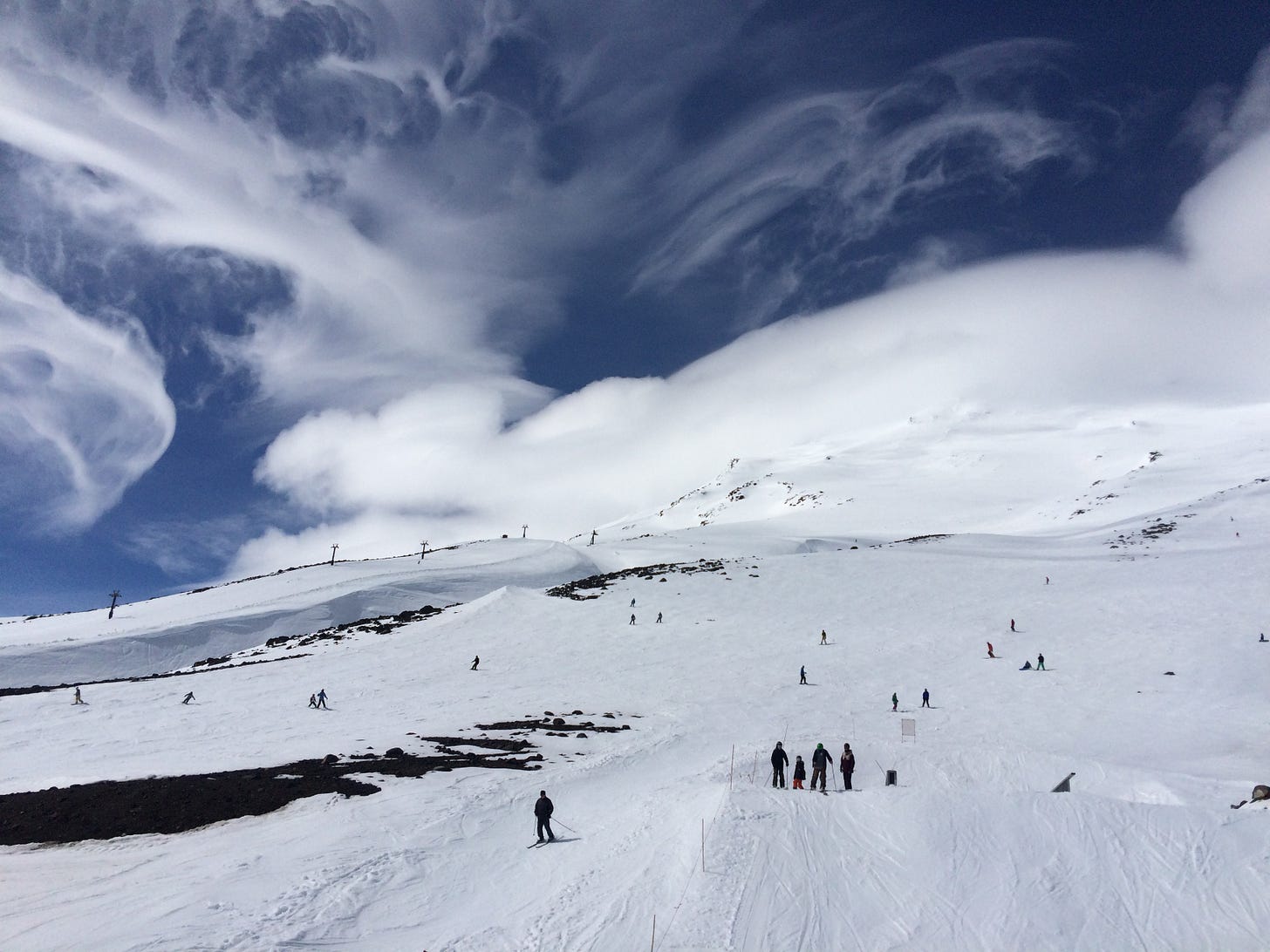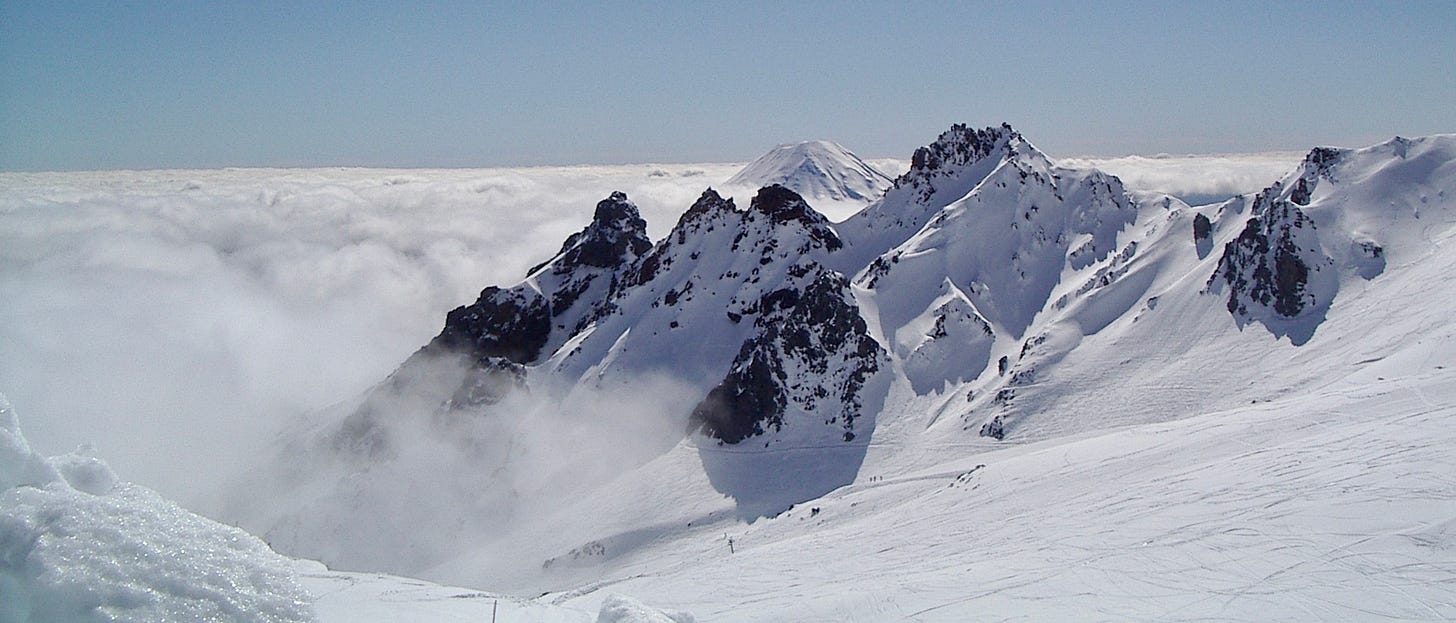Bankruptcy for Mt Ruapehu’s ski field operator
The perils of a not-for-profit company in a high-risk business
Ruapehu Alpine Lifts (RAL), the owner and operator of the Whakapapa and Turoa ski fields at Mt Ruapehu, was recently placed into receivership. Commentators, reflecting a particularly poor 2022 snow season for Ruapehu, have been quick to blame climate change. But, as any skiing tragic will happily tell you, 2022 was an awesome snow year for New Zealand — just not on Mt Ruapehu. There is clearly more to the story than climate change.1
Others have pointed to Covid disruptions in 2020 and 2021, which were otherwise pretty good snow years for Ruapehu. RAL made some big debt-funded capital investments in the 2010s (including the $25m Sky Waka gondola), then got hit by 3 low-revenue seasons in a row. This depleted their (otherwise reasonable) level of financial reserves, finally pushing them over the edge into receivership.
I’ve been skiing in NZ for 30 years, and been a regular at Ruapehu since 2005. I don’t have any inside knowledge of RAL’s difficulties, but do think there is an interesting story to tell about ski fields, risk management, and corporate form.
Ski field operation is a risky business
Ski lift infrastructure is very capital intensive. You can expect to spend $10m or more on a fancy modern chairlift or gondola. (A large ski field needs multiple such lifts.) And then you need roads, cafes, snow groomers, hire equipment, etc. These things all need to be in place well before winter, and paid for whether it snows or not.
Ski field operations are completely reliant on weather. Snow is essential. But too much isn’t great either. I was once told by the operator of a ski field that in their best ever snow season they teetered close to financial ruin, as it was costing far too much to clear the snow off their access road.
Snow-making machinery can fill in gaps in the natural falls, but only if the weather cooperates with cold, windless conditions. And snow-making is (you guessed it) capital intensive. Snowmaking is an insurance policy that pays off in worse-than-average seasons, but it is rarely sufficient to fix a really poor season, and unnecessary in a good season.
And even in a season with plenty of snow, rain can unexpectedly wash away lots of lovely white stuff. Or a field might have dangerous avalanche conditions, restricting skiing access (e.g. Treble Cone in 2022). And, to really bring the paying punters in, you need fine weather too. Ideally coinciding with weekends.
The ski field business is very risky because of the combination of capital intensity and weather dependence. For simplicity, I’ll call this combination “snow risk”.
How do NZ ski fields manage their snow risk? It depends on scale
New Zealand has 23 ski fields.2 All of them transfer some snow risk to customers, by selling season tickets. (These are steeply discounted pre-season, before anyone knows whether or not the snow will come.) And they transfer some risk to employees, by employing them on casual contracts. Other than that, risk management varies by the scale of the field.
Small, not-for-profit, club fields with minimal infrastructure
The majority of NZ fields are small not-for-profit operations owned by clubs (e.g. Broken River, Manganui, Tukino, Awakino, Fox Peak). These clubs have kept their capital investments low by using inexpensive rope tows, and avoiding or minimising snow grooming. They fall back on volunteer labour for some tasks, more so if their finances get stretched.
Mid-sized, family-owned fields with second-hand infrastructure
NZ has several mid-sized ski fields. These are mostly family owned (e.g. Ohau, Mt Dobson, Round Hill). The owners reduce their infrastructure costs by using second-hand equipment, e.g. hand-me-down chairlifts and groomers from the larger fields. (They also favour T-bars and pomas, which are cheaper than chairlifts.) Family ownership can mean family labour in tough times — famously Peter Foote’s wife and children spent their free time making concrete pipes for the Mt Dobson access road in the 1970s.

Large, multi-site, (mostly) corporate-owned fields with modern infrastructure
New Zealand has three large skiing operators, each with multiple fields. Two are large, privately held corporates: NZSki (Mt Hutt, Coronet Peak, the Remarkables) and RealNZ (Cardrona, Treble Cone).3 They fund capital expenditure through a combination of equity (selling shares), debt (borrowing), and retained profits. NZSki diversifies its snow risk geographically4, and RealNZ diversifies its risk at a corporate level by operating both summer and winter attractions.5
And then there’s RAL. Two large ski fields, on the same mountain. Very little in the way of risk diversification.6 Which is surprising, given that Mt Ruapehu is an especially trying environment, due to:
eruptions — it is an active volcano. Eruptions closed the ski fields for part of the 1995 season, all of the 1996 season, and briefly in 2007.
wind — it is high above the rest of the North Island, and very exposed to the wind, which can close the fields on otherwise suitable skiing days.
ice — the combination of strong winds and humid air is perfect for creating ice, the bane of skiers and ski-lift infrastructure.
Added to that, RAL has an unusual corporate form — a large not-for-profit company (NFP).
What are not-for-profits doing at both ends of the scale?
This is where the story gets intriguing. The case for not-for-profit corporate forms is clear for the small club fields. But what is one doing at the top end of the scale? I suspect it’s an accident of history, one which had to come unstuck at some point.
The idea of a NFP is naturally appealing to customers, who assume that they are the beneficiaries (through lower prices) of not having to pay profits to a company’s owners. This story is, however, overly simplistic. Ski field infrastructure has to be paid for by someone. Just as interest is the rental cost of debt capital, profits are the rental cost of equity capital. But, unlike equity, debt has to be repaid in bad years as well as good. Debt-loaded companies are thus more fragile than those with a healthy balance of debt and equity.
A reliance on debt funding makes NFPs poorly suited to industries with high capital intensity.7 NFPs lack investors, who can be called on to recapitalise a failing business, or fund an expanding one. Lenders, understanding these limitations, can be reluctant to lend to NFPs, which makes them even more capital-constrained.
What now for skiing at Mt Ruapehu?
I think the most likely future for the Ruapehu ski field involves being sold by the receivers to a large for-profit company. Given the size of the operation and the need to diversify snow risk, there are few prospective NZ buyers.
Purchase may well be an an attractive proposition for an overseas operator. There are diversification advantages to owning fields in both the Northern and Southern hemispheres. Australians own ski resorts in Japan, for example, while US companies own ski resorts in Australia. New Zealand ski fields have all been domestically owned to date, but perhaps no longer.
On a purely personal note, I’m hoping this gets sorted in time for a great winter season at Mt Ruapehu in 2023.
By Dave Heatley
NZ lacks a good record of historical snow data. However, there is good data for Spencers Creek in Australia’s Snowy Mountains, which is at a similar latitude to Mt Ruapehu. One analysis, reporting data from 1954 to 2021, identified 1981 as the best, and 1982 as the worst, snow years — a neat demonstration that year-to-year variability tends to swamp long-term trends. The analysis reported that while the 1950s and 60s were unusually high snowfall years, “in recent decades there has been no trend for the snow depth to become less or of shorter duration”.
I count 23 or thereabouts, depending on how you define a ski field. I’m counting fields with fixed ski-lift infrastructure, and road access for customers (albeit with a bit of walking in a few cases, such as Temple Basin). I have excluded helicopter-based skiing operations.
RealNZ was formerly called Real Journeys. It also operates transport services to and attractions on Stewart Island, and boat cruises in Milford and Doubtful Sounds, and on Lake Te Anau.
NZSki’s resort at Mt Hutt is subject to different weather and snow conditions than are its Queenstown fields.
Owning both summer and winter tourist attractions also allows RealNZ to make better use of some infrastructure (e.g. buses, sales offices), and to offer year-round employment to staff.
To be fair, in recent years RAL tried to beef up its summer attractions by constructing the Sky Waka gondola. Timing worked against RAL — the gondola is yet to have a summer season unaffected by Covid restrictions. The $25m Sky Waka project was funded in part by a Provincial Growth Fund loan of $10m, and $9.5m from the Tuwharetoa Trust.
RAL has been quite creative at times in raising capital from its customers. At one time it offered priority lift queue access to purchasers of its “shares” (these have voting rights, but no rights to dividends). In more recent years, it has sold life passes, which bring forward revenue from its more dedicated customers, who may otherwise have bought season passes every year. Technically, life pass sales don’t raise capital, as they are matched by a contingent liability to provide free skiing for the life of the customer. But, in practice, life pass sales are a good source of cash to help fund infrastructure.






